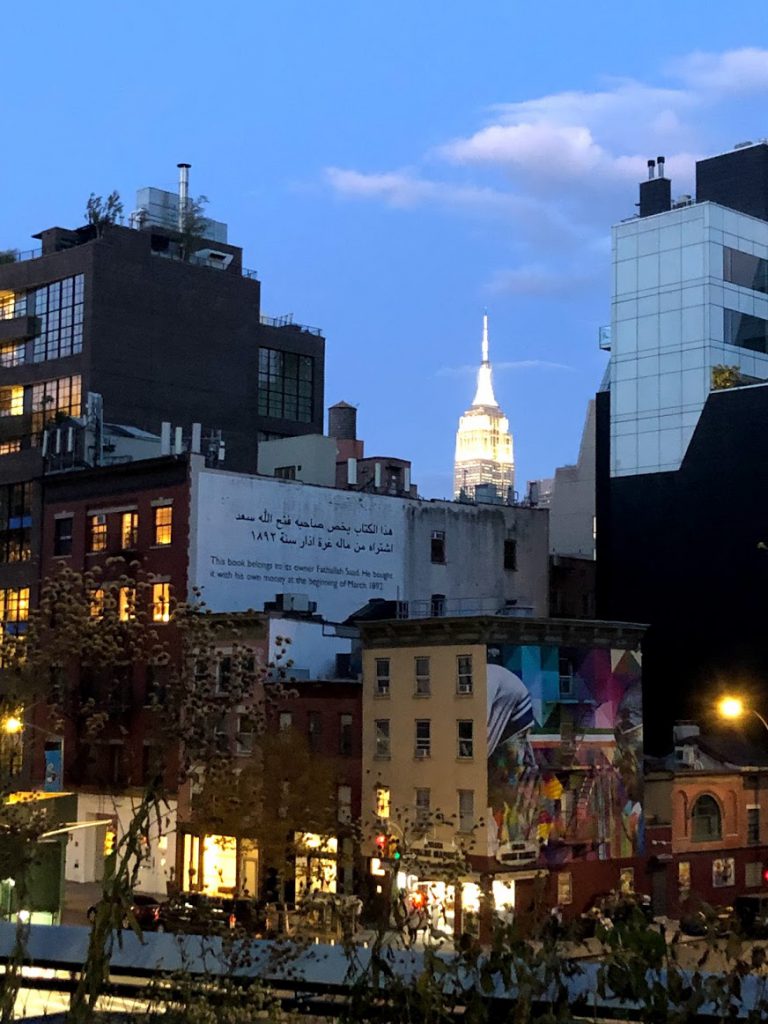
I took this photo while walking on The High Line last September. I started wondering what the Arabic sentence meant only when I looked at the photo recently reminiscing about the pleasure of walking in a crowded area. With the miracle of Internet, I was able to quickly find out that it was an installation by a Palestinian artist Emily Jacir.
ex libris commemorates the approximately thirty thousand books from Palestinian homes, libraries, and institutions that were looted by Israeli authorities in 1948.
Not knowing much about the Israeli-Palestinian politic, I can’t really comment on the political aspect of the work. However, it made me wonder if one of the thirty thousand books could be the book that is a foundation of modern computing that allowed me to write this post on a computer. The book “Rules of restoring and equating” is written by Muhammad ibn Musa al-Khwarizmi (c. 825) and the latinized word “algorithm” is derived from his name.
This is a little known fact that I learned when I was studying computer science (the field I chose after all my options ran out) as an undergraduate. This is probably a fact that most Americans are ignorant of even though nowadays everyone at least heard of the word “algorithm”. Of course, a popular image of the middle east is the land of savagery and war-mongering, not the enlightenment.
In The Western Lands (probably a perfect book to read during a quarantine), William S. Burroughs acknowledges this intellectual debt the world owes to the Islamic world by using the company his grandfather founded as an example:

Much like the legacy of the Islamic world is veiled by Yashmak and being forgotten by the rest of the world, the legacy of the Burroughs corporation and William S. Burroughs (a perfect example of xenogenesis) himself seems to be disappearing. The Burroughs corporation had invented adding machines (mechanical computers that are literally made out of steel and wood) in the 19th century and introduced a series of technical breakthroughs since then only to become a shadow of itself later. William S. Burroughs, who invented the cut-up technique, is now only given that dreadful title “a controversial gay writer”.

Dear In,
It was a pleasure to read your piece. I didn’t know the origins of the word “algorithm” but that connection makes perfect sense. Your observations reminded me of my study of Islamic Spain (I had bought tickets and was all set to visit Andalusia this past March but Corona struck). I remember reading that Muslim scientists, mathematicians, and doctors were intent on learning as much as they could about Allah’s creation. They were determined to know how it all worked. As you point out, much of their influence is shrouded in obscurity now because in the everyday life of the west, Islam has become the “other”. Some truths go unacknowledged.
Thank you, Rodrigo! I always find how one culture influences another fascinating and the Arabic influence on Spain and to some extent on Latin America is beyond fascinating. I am reminded of Borges’s short story “Covered Mirrors”. How he opens that story with a profound Islamic notion and transforms it into a personal story is truly unique and inimitable. I hope you will continue your journey to Andalusia once this is all over and document your experiences here!
Dear In,
I don’t know Borges as well as I should. I will find that story. As you point out in your piece, Medieval European history was much more complex because of the influence of the Muslims and the Jews. I do find Spain fascinating for that reason. There is a fascinating collection of poems/vignettes by Eduardo Galeano called Memory of Fire. It traces the entire history of Latin America. In a passage that describes Colombus’ landing on the shore of what would become the Bahamas, the accompanying translator spoke to the Lucayan natives in a variety of languages including Arabic because they thought they were in Asia. How fascinating to think that Arabic was being spoken on a sandy beach in the Bahamas in 1492. Your piece also reminded me that I need to read Bourroughs as well!
Dear In,
Thank you for this wonderful post. Like Rod I’m fascinated to learn the origin of the word algorithm. Not until now do I realized that I had assumed it was a rhythm of the algo-kind. Your posting evoked this short short poem by an 11th C. poet by the name of Ibn Ammar:
“My eye frees what the page imprisons:
The white the white and the black the black”
Rod, have you read “the Ornament of the World,” by Maria Rosa Menocal, a portrait of the vibrant civilization of medieval Spain, Andalusia in particular. A trip to Andalusia is on my bucket list as well.
Dear Erik (and In)
That was the exact book I had in mind when In referenced Muslim mathematicians. Menocal’s depiction of Islamic Spain opened up a whole new take on European (if not world) history for me. Now that I think about it, I took a history class in undergrad called “Visions of the Other” which analyzed Spanish perceptions of Muslims, Jews, Aztecs, Incas, etc. as depicted in the primary sources. In’s piece is a continuation of that analysis, providing a contemporary example of a buried past. Not to be too conspiratorial, but the current climate of our government thrives on the existence of a menacing “other”. We seem far from hailing muslim mathematicians in our middle or high school algebra classes (algebra being another word rooted in Arabic).